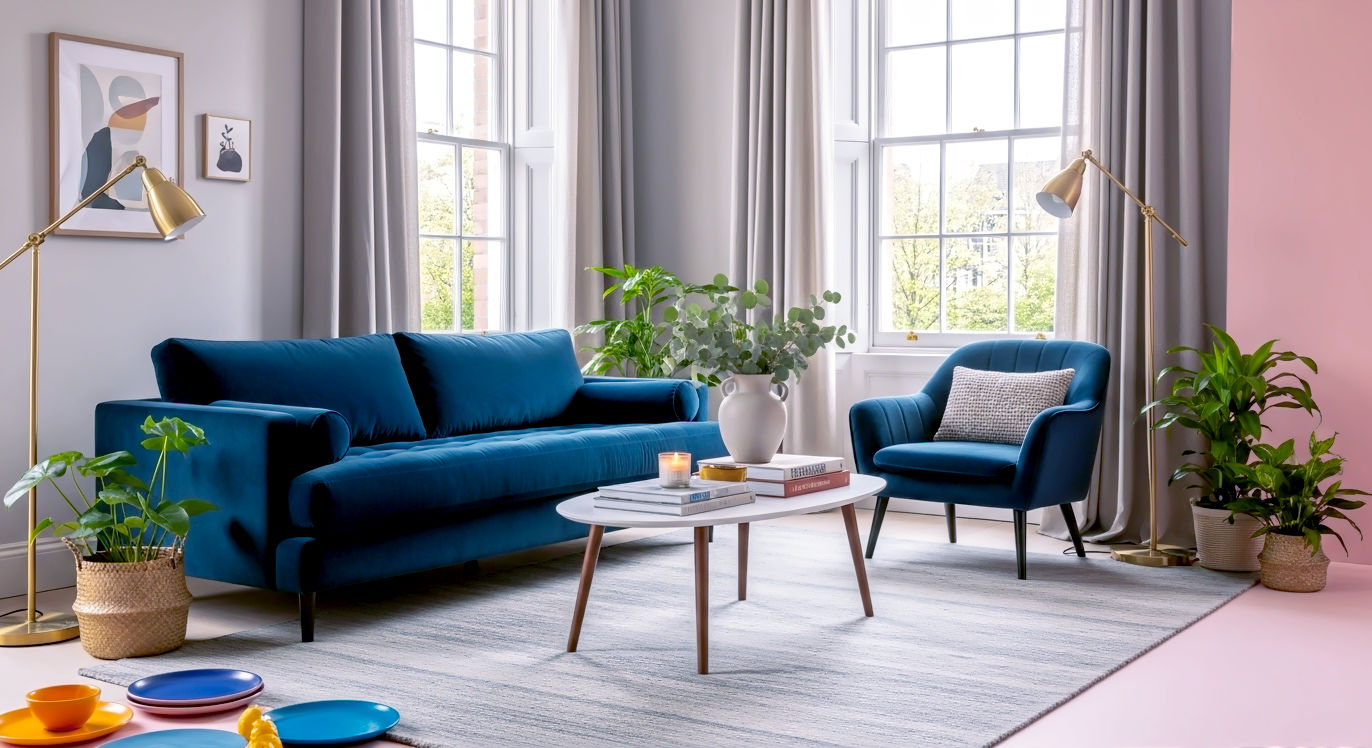5 Ways to Make Your Living Room Look More Chic: The Very British Guide
Feeling uninspired by your living room? Our definitive guide reveals 5 achievable ways to make it look more chic, with practical tips for British homes.

This post may contain affiliate links. If you make a purchase through these links, we may earn a commission at no additional cost to you.
Hello there! Is your living room feeling a bit… blah? You know the feeling. It’s where you unwind after a long day, have a cuppa with a friend, or binge-watch that new series everyone’s talking about. But sometimes, it just doesn’t feel quite right. It’s functional, sure, but it’s missing that certain something. That little bit of magic that makes you think, “Wow, I love this room.”
If you’re dreaming of a living room that looks like it’s straight out of Ideal Home or Elle Decor but don’t know where to start, you’re in the right place. Making a space look ‘chic’ isn’t about spending a fortune or having some secret interior design degree. Honestly, it’s about making smart, thoughtful choices that reflect your personality and make the room feel calm, collected, and effortlessly stylish.
Think of it like putting together a great outfit. You don’t just throw on random clothes. You pick pieces that go together, add a nice accessory or two, and make sure it all fits just right. Your living room is exactly the same.
In this guide, we’re going to walk you through five simple, achievable ways to transform your living room from drab to fab. We’ll cover everything from the colours on your walls to the cushions on your sofa. We’re not talking about knocking down walls or ripping out floors. These are real, practical tips that anyone can use, whether you live in a tiny London flat, a semi-detached in Manchester, or a cottage in the Cotswolds.
So, grab a biscuit (or two), get comfortable, and let’s get started on creating a living room you’ll be proud to show off.
1. Master Your Colour Palette: The Foundation of Chic
Before you do anything else, let’s talk about colour. The colours you choose for your living room are like the backdrop to a play – they set the mood for everything. Get the palette right, and you’re halfway to a chic space. Get it wrong, and the room will always feel a bit off, no matter how lovely your furniture is.
A chic colour palette isn’t about following fleeting trends. It’s about creating a timeless, sophisticated, and harmonious feel. The secret? It’s all in the 60-30-10 rule.
Don’t worry, it sounds more technical than it is! It’s a classic interior design principle that’s super easy to follow.
- 60% is your main colour: This is the dominant shade in your room. It covers the most surface area, so think walls, large rugs, and maybe even your sofa. This colour should be something you love and can live with. Often, a neutral shade works best here because it’s calming and acts as a perfect canvas.
- 30% is your secondary colour: This colour is there to add a bit of interest and contrast. It should be used for about half the amount of your main colour. Think curtains, an accent chair, a painted bookcase, or even a feature wall.
- 10% is your accent colour: This is where you can have some fun! It’s the little pop of colour that brings everything to life. Use it for things like cushions, throws, artwork, lampshades, and decorative bits and bobs.
How to Choose Your Colours
Okay, so you understand the rule, but how do you pick the actual colours? This is the fun part. The best place to start is with a colour you absolutely adore. It could be the deep blue of the sea in Cornwall, the soft green of the Yorkshire Dales, or the warm terracotta of a London brick.
The Power of Neutrals
When we say ‘neutral’, don’t just think beige or magnolia. Modern neutrals are far more exciting. Think about:
- Warm Greys: Softer and cosier than cool greys. Brands like Farrow & Ball have beautiful options like ‘Elephant’s Breath’ or ‘Skimming Stone’ that change subtly with the light.
- Greige: A mix of grey and beige, this is the ultimate versatile neutral. It’s warm but not yellow, cool but not cold.
- Off-Whites: Pure brilliant white can feel a bit stark and clinical, like a doctor’s surgery. An off-white with a hint of grey, yellow, or even pink feels much softer and more sophisticated. Think ‘Wimborne White’ or ‘Pointing’.
- Muted Greens and Blues: These colours, inspired by nature, can act as neutrals. A soft sage green or a dusty duck egg blue can make a room feel incredibly serene and chic.
A quick tip: Before you commit, always, always test your paint colours. Paint a large piece of card or a section of the wall and see how it looks at different times of the day. The light in a north-facing room is very different from a south-facing one, and it can completely change how a colour looks.
Finding Your Secondary and Accent Colours
Once you have your main neutral, picking the other colours is easier. A colour wheel can be your best friend here.
- For a calm, harmonious look (Analogous): Choose colours that sit next to each other on the colour wheel. If your main colour is a soft green, your secondary could be a deeper forest green, and your accent could be a teal or a hint of yellow.
- For a bolder, more dynamic look (Complementary): Choose colours that are opposite each other on the colour wheel. If you’ve gone for a navy blue wall (as a secondary colour), a pop of burnt orange or mustard yellow in your cushions (your accent) will look absolutely fantastic.
A Real-World Example
Let’s imagine a living room.
- 60% Main Colour: The walls are painted in a soft, warm grey like ‘Ammonite’ from Farrow & Ball. The large rug is a similar, slightly deeper grey.
- 30% Secondary Colour: The sofa is a beautiful, rich navy blue velvet. The curtains have a subtle navy pattern on a cream background.
- 10% Accent Colour: There are a couple of cushions in a vibrant mustard yellow. A brass floor lamp stands in the corner, and a vase on the mantelpiece has a touch of yellow in its design.
Can you picture it? It feels balanced, interesting, and incredibly chic. It’s not boring, but it’s not chaotic either. That’s the magic of a well-planned colour palette.
2. Furniture Layout: Create Flow and Conversation
Have you ever walked into a room where all the furniture is pushed up against the walls? It’s a really common mistake. People often think it will make the room look bigger, but it usually does the opposite. It can create a strange, empty space in the middle – a sort of furniture no-man’s-land – and make the room feel cold and impersonal.
A chic living room is all about creating a sense of intimacy and flow. It should be a space that invites people in and encourages them to sit down and chat. The way you arrange your furniture is key to achieving this.
The Art of the ‘Float’
One of the biggest secrets of high-end interior design is ‘floating’ your furniture. This simply means pulling your sofa and chairs away from the walls. You don’t need a massive room to do this. Even pulling your sofa forward by just a few inches can make a huge difference. It creates a sense of space and makes the arrangement feel more deliberate and designed.
Create Conversational Zones
Your living room isn’t just for watching telly. It’s for living! Think about how you use the space. The main goal is to arrange the furniture in a way that makes it easy to have a conversation without having to shout across the room.
- Start with a Focal Point: Your focal point is the star of the room. It could be a beautiful fireplace, a large window with a lovely view, or even a piece of statement art. Arrange your main seating around this point. If your TV is your focal point (and let’s be honest, for many of us it is), try to make it less obvious. You could have it as part of a larger shelving unit or on a stylish media cabinet.
- Arrange Seating to Face Each Other: Position your sofa and chairs so they are roughly facing each other. They don’t have to be in a perfect, rigid square. An L-shape with a sofa and two armchairs works beautifully. The idea is that when people are sitting, they can easily make eye contact. A good rule of thumb is to keep seating no more than 8 feet apart.
- Anchor the Space with a Rug: A rug is essential. It pulls the whole seating area together and defines the zone. Your main furniture (at least the front legs of your sofa and chairs) should sit on the rug. This is a really important step – a tiny rug floating in the middle of the floor will make everything look disconnected. Make sure you get a rug that’s big enough!
Think About Traffic Flow
How do you walk through the room? You need to leave clear pathways so people can move around easily without having to squeeze past furniture or trip over things.
Imagine the main routes – from the door to the sofa, or from the sofa to the window. Keep these paths clear. As a general guide, you need about 3 feet of space for a main walkway.
The Importance of Tables
Every seat needs a surface nearby where you can put down a cup of tea or a book.
- Coffee Table: The classic choice. Place it about 14-18 inches away from your sofa – close enough to reach, but far enough that you can walk past.
- Side Tables: These are perfect next to armchairs or at the ends of your sofa. They don’t have to match! In fact, mixing and matching tables adds character. A small wooden table on one side and a sleek metal one on the other can look fantastic.
By thinking about your layout in this way, you’re not just filling a space with furniture. You’re creating an experience. You’re designing a room that works for the people who use it, making it comfortable, practical, and undeniably chic.
3. Layer Your Lighting: Crafting the Perfect Ambience
Lighting is one of the most powerful tools in an interior designer’s toolkit. It’s also something that many of us get wrong. Often, a living room has just one main light source – a single pendant hanging from the middle of the ceiling. You flick the switch, and the whole room is flooded with a flat, unflattering light. It’s functional, but it’s not chic.
A beautifully designed room uses layered lighting. This means having a mix of different light sources at different heights, which you can use to create different moods. Think of it like painting with light. You want pools of soft, warm light that make the room feel cosy and inviting.
There are three main types of lighting you need to think about.
1. Ambient Lighting (The General Glow)
This is your main, overall light source. It’s the replacement for that single, lonely ceiling pendant.
- The Big Light: It could still be a ceiling fixture, but choose something with style. A beautiful chandelier, a modern sculptural pendant, or a smart semi-flush mount light can act as a piece of jewellery for the room. Crucially, put it on a dimmer switch! This is non-negotiable. Being able to dim the main light is the single most effective way to change the atmosphere of the room instantly.
- Wall Lights (Sconces): These are great for adding a soft glow around the edges of the room, making it feel larger and more open.
- Recessed Spotlights: These can work well, especially in modern homes, but use them carefully. Angle them to wash light down a wall or highlight a feature like a bookcase, rather than just pointing them straight down into the middle of the room.
2. Task Lighting (For Getting Things Done)
This is focused light for specific activities. It’s practical, but it can also be very stylish.
- Reading Lamps: If you have a favourite armchair where you like to curl up with a book, place a floor lamp right next to it. An elegant arc lamp that hangs over the chair not only provides perfect light but also creates a beautiful design feature.
- Desk Lamps: If you have a small desk or work area in a corner of your living room, a smart desk lamp is essential.
3. Accent Lighting (The Magical Sparkle)
This is the fun layer! Accent lighting is all about adding depth, drama, and interest. It’s what makes a room feel really special and professionally designed.
- Picture Lights: A small, discreet light mounted above a piece of art will make it look a million times more important and draw the eye.
- Uplighters: Placing a simple can-style uplighter on the floor behind a large plant or in an empty corner can create beautiful shadows on the ceiling and make the room feel taller.
- Table Lamps: These are your best friends. Dot them around the room on side tables, console tables, and shelves. They provide a lovely, warm, human-level glow. You can never have too many table lamps! Choose shades that diffuse the light softly. A thick, dark lampshade will only cast light up and down, while a linen or fabric shade will create a much warmer ambience.
Pulling It All Together
The goal is to have a flexible system. During the day, you might just have natural light. In the early evening, you might turn on a couple of table lamps for a cosy feel. If you have guests over, you might have the main light on low, with all your table lamps and accent lights on to create a warm, welcoming glow.
A final tip on light bulbs: Pay attention to the colour temperature. Look for bulbs labelled ‘warm white’ (around 2700K). These give off a soft, slightly yellow light that is much more flattering and relaxing than the harsh, blue-tinged light of ‘cool white’ bulbs. It’s a small detail that makes a world of difference.
4. Play with Texture and Textiles: Add Warmth and Depth
A room can have the perfect colour palette and layout, but if everything is flat and one-dimensional, it will still feel cold and a bit boring. The secret to making a room feel rich, cosy, and luxurious is texture.
Think about how things feel, not just how they look. You want to create a space that makes you want to reach out and touch things. Layering different textures is what gives a room its character and depth. It’s the difference between a sterile showroom and a warm, inviting home.
Where to Add Texture
Your living room is full of opportunities to play with textiles and materials.
On the Floor
We’ve already mentioned the importance of a rug for anchoring your seating area, but it’s also your first big opportunity to add texture.
- Wool Rugs: A thick, deep-pile wool rug feels incredible underfoot and instantly makes a room feel cosier.
- Jute or Sisal Rugs: These natural fibre rugs bring a lovely, rustic, organic texture to a room. They are perfect for a more relaxed, Scandi-inspired or coastal look.
- Layering Rugs: For a really chic, eclectic vibe, try layering a smaller, patterned rug (like a vintage Persian-style one) on top of a larger, plain jute rug.
On the Sofa and Chairs
This is where you can really go to town. Cushions and throws are the easiest and most affordable way to change the look and feel of your living room.
- Mix Your Materials: Don’t just have a row of matching cotton cushions. Mix it up! Try a combination of velvet, linen, wool, and even a bit of faux fur. The contrast between the sleek sheen of velvet and the rougher texture of linen is what creates interest.
- Vary Shapes and Sizes: Use a mix of square and rectangular cushions. A larger 50x50cm cushion at the back with a smaller one in front looks great.
- Throws: A chunky knit wool throw casually draped over the arm of the sofa or a soft cashmere blanket folded on an armchair is the definition of cosy chic.
At the Windows
Your window treatments are another huge area of fabric in the room.
- Curtains: Floor-to-ceiling curtains make a room feel taller and more elegant. Choose a fabric with some weight to it so it hangs beautifully. Linen gives a relaxed, airy feel, while velvet is more formal and dramatic. Even if you have blinds for privacy, adding ‘dress’ curtains (curtains that don’t necessarily close but just frame the window) can soften the whole room.
- Blinds: A simple Roman blind in a beautiful fabric can look very chic and tailored. Wooden or bamboo blinds add a nice, natural texture.
Beyond Textiles
Texture isn’t just about soft furnishings. Think about the other materials in the room.
- Wood: The grain of a wooden coffee table or the side of a bookshelf.
- Metal: The cool smoothness of a brass lamp or a chrome picture frame.
- Glass and Mirror: Reflective surfaces add a touch of glamour.
- Ceramics: A collection of rustic, handmade ceramic vases on a shelf.
- Plants: Don’t forget living texture! The leaves of a fiddle-leaf fig or the fronds of a fern add life and an organic element to the room.
By consciously mixing these different materials and textures, you create a room that is visually interesting and tactilely pleasing. It feels layered, collected over time, and deeply personal – the very essence of chic.
5. Accessorise with Intention: The Finishing Touches
This is the final, crucial step. Accessories are the soul of a room. They are the little details that tell a story about who you are and what you love. However, there’s a fine line between a beautifully curated collection and just… clutter.
A chic living room isn’t packed to the rafters with stuff. Every object feels like it has a purpose and a place. The key is to accessorise with intention.
Curation is Everything
Think of yourself as the curator of a small museum – your home. You wouldn’t just put any old thing in a display case. You’d choose items that are beautiful, meaningful, or interesting.
- Less is More: It’s better to have one large, impactful piece of art on a wall than lots of little, ditsy pictures. It’s better to have three beautiful, handmade vases on a shelf than a dozen cheap knick-knacks.
- Go Big: When in doubt, go for larger-scale accessories. A big floor lamp, an oversized mirror, or a tall vase with a few dramatic branches will have a much bigger impact than lots of small items, which can just look messy.
- Edit, Edit, Edit: Step back and look at your surfaces – your mantelpiece, your coffee table, your shelves. Is it too crowded? Take everything off and start again. Only put back the things you truly love. This is a brilliant trick used by stylists.
What to Accessorise With
Artwork
Art is one of the most personal things you can put in your home. It doesn’t have to be an expensive original painting. It could be:
- A large-scale photograph you love.
- A framed vintage travel poster.
- A collection of black-and-white family photos in matching frames.
Top Tip: Hang your art at the right height. The centre of the picture should be at eye level, which is roughly 57-60 inches from the floor. People tend to hang art too high, which makes it feel disconnected from the furniture.
Mirrors
A large mirror can be transformative. It will bounce light around the room, making it feel brighter and bigger. An oversized mirror leaning against a wall is a classic, effortlessly chic look. Position it opposite a window to maximise the light.
Books
Don’t hide your books away! Stacks of beautiful coffee table books on a side table or a well-organised bookshelf add colour, personality, and intelligence to a room. Organise them by colour for a really graphic, stylised look, or simply by size.
Plants and Flowers
Every single chic living room you’ve ever seen in a magazine will have plants or flowers. They add life, colour, and a natural, sculptural element.
- Go for variety: A tall plant in a corner (like a Kentia Palm or a Ficus), a smaller one on a bookshelf, and a trailing plant (like a String of Pearls) hanging from a shelf create layers of greenery.
- Fresh flowers: A simple bunch of tulips or a few stems of eucalyptus in a nice vase on the coffee table is a small luxury that makes a huge difference.
Personal Objects
This is what makes your home yours. It could be a beautiful bowl you picked up on holiday in Greece, a collection of old glass bottles you found at a car boot sale, or a sculpture your child made. Group these items together in little collections or ‘vignettes’.
The Rule of Three
When arranging objects on a surface, the ‘rule of three’ is your secret weapon. For some reason, our brains find groupings of three (or any odd number) more appealing and balanced than even-numbered groups.
Try arranging a group of three objects of different heights on your coffee table. For example: a stack of books (low), a small plant in a pot (medium), and a tall candle in a holder (high). This creates a pleasing, dynamic arrangement.
Conclusion: Your Chic Living Room Awaits
And there you have it. Five straightforward, effective ways to make your living room look more chic. As you can see, it’s not about having a huge budget or a perfect show home. It’s about being thoughtful and intentional.
Let’s quickly recap:
- Master Your Colour Palette: Use the 60-30-10 rule to create a balanced and sophisticated colour scheme.
- Perfect Your Furniture Layout: Pull furniture away from the walls and create intimate, conversational zones.
- Layer Your Lighting: Use a mix of ambient, task, and accent lighting on dimmer switches to create the perfect mood.
- Play with Texture: Mix materials like velvet, linen, wool, wood, and metal to add warmth and depth.
- Accessorise with Intention: Curate your belongings, go for larger-scale items, and tell your personal story.
The most important thing to remember is that this is your home. A truly chic space is one that is not only beautiful and well-designed but also a comfortable, authentic reflection of the people who live there.
Don’t be afraid to experiment. Move things around. Try a new cushion cover. Buy that lamp you’ve been eyeing up. Small changes can make a massive difference. Take your time, enjoy the process, and create a living room that you can’t wait to come home to.
Further Reading
For more inspiration and advice from trusted UK sources, we recommend exploring these websites:
- House & Garden UK: A bible for classic British interior design, full of beautiful homes and expert advice.
- Livingetc: For a more modern, trend-led approach to decorating.
- The Design Sheppard: An award-winning UK interior design blog with product reviews, trends, and tips.
- Mad About The House: Written by journalist Kate Watson-Smyth, this is a fantastic resource for real-world advice and design wisdom.






